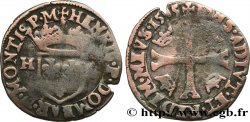fme_1043974 - ESPAÑA - REINO DE ESPAÑA - FELIPE III Médaille, Domenicos Theotocopulos
150.00 €
Cantidad
Añadir a su cesta

Tipo : Médaille, Domenicos Theotocopulos
Fecha: n.d.
Nombre del taller / ciudad: Espagne, Tolède
Metal: bronce
Diámetro: 79 mm
Eje de acuñación: 12 h.
Acuñador ROUSSEAU Émile (1927-2010)
Peso: 241,01 g.
Canto: lisse
Cuño: sans poinçon
Comentarios sobre el estado de conservación:
Patine sombre hétérogène avec la présence de traces d’oxydation et de quelques rayures sur la tranche
N° en los catálogos de referencia :
Anverso
Titulatura del anverso: DOMENICOS THEOTOCOPULOS.
Descripción del anverso: Portrait de face. Signé : ER.
Reverso
Titulatura del reverso: TOLEDO.
Descripción del reverso: Représentation du blason et de la ville de Tolède.
Comentario
Le Grec, né Doménikos Theotokópoulos (1541 - 7 avril 1614), est un peintre, sculpteur et architecte de la Renaissance espagnole . "Le Grec" était un surnom, une référence à son origine nationale grecque, et l'artiste signait normalement ses peintures avec son nom de naissance complet en lettres grecques , Δομήνικος Θεοτοκόπουλος ( Doménikos Theotokópoulos ), en ajoutant souvent le mot Κρής ( Krēs , « Crétois »). Le Grec est né en Crète, qui faisait alors partie de la République de Venise et était le centre de l'art post-byzantin. Il se forme et devient un maître dans cette tradition avant de se rendre, à l'âge de 26 ans, à Venise, comme l'avaient fait d'autres artistes grecs. En 1570, il s'installe à Rome, où il ouvre un atelier et exécute une série d'œuvres. Pendant son séjour en Italie, le Grec enrichit son style d'éléments du maniérisme et de la Renaissance vénitienne. En 1577, il s'installe à Tolède, en Espagne, où il vit et travaille jusqu'à sa mort. C'est à Tolède que le Grec reçut plusieurs commandes importantes et réalisa ses peintures les plus connues..
The Greek, born Doménikos Theotokópoulos (1541 – 7 April 1614), was a painter, sculptor, and architect of the Spanish Renaissance. \\\"The Greek\\\" was a nickname, a reference to his Greek national origin, and the artist normally signed his paintings with his full birth name in Greek letters, Δομήνικος Θεοτοκόπουλος (Doménikos Theotokópoulos), often adding the word Κρής (Krēs, \\\"Cretan\\\"). The Greek was born in Crete, which was then part of the Republic of Venice and the center of post-Byzantine art. He trained and became a master in this tradition before going, at the age of 26, to Venice, as other Greek artists had done. In 1570, he moved to Rome, where he opened a studio and executed a series of works. During his stay in Italy, the Greek enriched his style with elements of Mannerism and the Venetian Renaissance. In 1577, he moved to Toledo, Spain, where he lived and worked until his death. It was in Toledo that the Greek received several important commissions and created his most famous paintings.
The Greek, born Doménikos Theotokópoulos (1541 – 7 April 1614), was a painter, sculptor, and architect of the Spanish Renaissance. \\\"The Greek\\\" was a nickname, a reference to his Greek national origin, and the artist normally signed his paintings with his full birth name in Greek letters, Δομήνικος Θεοτοκόπουλος (Doménikos Theotokópoulos), often adding the word Κρής (Krēs, \\\"Cretan\\\"). The Greek was born in Crete, which was then part of the Republic of Venice and the center of post-Byzantine art. He trained and became a master in this tradition before going, at the age of 26, to Venice, as other Greek artists had done. In 1570, he moved to Rome, where he opened a studio and executed a series of works. During his stay in Italy, the Greek enriched his style with elements of Mannerism and the Venetian Renaissance. In 1577, he moved to Toledo, Spain, where he lived and worked until his death. It was in Toledo that the Greek received several important commissions and created his most famous paintings.








 Informar de un error
Informar de un error Imprimir la página
Imprimir la página Comparte mi selección
Comparte mi selección Haz una pregunta
Haz una pregunta Consignar / vender
Consignar / vender
 Descriptivo
Descriptivo






